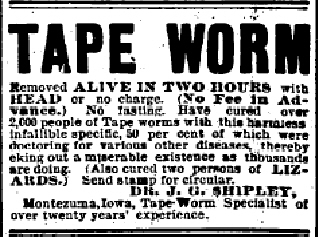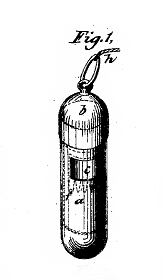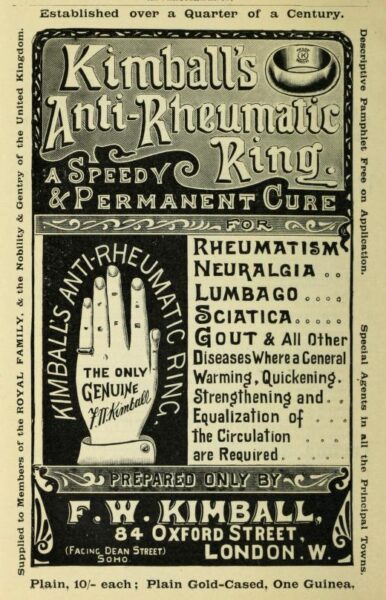TAPE WORM
Removed ALIVE IN TWO HOURS with HEAD or no charge. (No Fee in Advance.) No fasting. Have cured over 2,000 people of Tape worms with this harmless infallible specific, 50 per cent of which were doctoring for various other diseases, thereby eking out a miserable existence as thousands are doing. (Also cured two persons of LIZARDS.) Send stamp for circular.
Dr J. G. SHIPLEY
Montezuma, Iowa, Tape Worm Specialist of over twenty years’ experience.
Source: The Burlington Hawkeye, Iowa, 9 July 1895
………………………………………………………………………………
Tapeworm specialists advertised widely in late 19th-century American newspapers— Wait, what?… LIZARDS?
I wondered if ‘lizards’ was a colloquial term for some variety of parasite, but it seems Dr Shipley wasn’t the only one claiming to remove actual lizards from people’s innards. In 1900, Dr H D Rucker advertised that his medicine, ‘Korak Wonder’, had caused one Mrs E. J. Welker to expel a lizard ‘well formed and having four legs and feet.’
Tapeworm specialists had a variety of techniques and potions, but Charles Oleson, M.D, in Secret Nostrums and Systems of Medicine, describes a common method used by irregular practitioners. Oleson, though cataloguing the formulae of dodgy remedies, was not afraid to stand up for those he believed would work. This was one of which he heartily approved.
The patient must fast for a day, taking only a saline cathartic to empty the bowels. The next morning, he or she would take a teaspoon of the essential oil of male fern (whose Latin name, Dryopteris filix-mas, is one of the few things I remember from A-level biology) in a cup of warm milk. Milk was supposed to be ‘an article of food in which the tape-worm greatly delights.’
After this, the patient had to lie down for a few hours, keeping a slice of lemon handy in case of nausea, and then take a dose of castor oil, turpentine and croton oil – the latter being toxic and a rather drastic purgative. The spectacular effects of this mixture can be imagined. If you put a piece of mosquito netting over your chamber pot, ‘the worm itself can be easily retained for further examination,’ or for keeping as a pet or whatever.
Some tapeworm specialists did medicine shows in the street, and for this they needed to impress the punters by displaying preserved worms of enormous length. The Decatur Review (Illinois) in 1903 printed an anecdote about a worm doctor called Joe Bowen, who had given up a successful career as an auctioneer in order to go into the lucrative worm business. When he started out he did not have any specimens to display, and as the newspaper said:
If these tapeworm specialists haven’t something to show and scare the people, there is no use for them to set up.
Mr Bowen found an inventive solution:
He borrowed a crimping machine then he went to the slaughterhouse and gathered a lot of entrails. In a few hours after that, Joe had the finest exhibit of tapeworms that ever went on the street.
The exhibit did the trick and Bowen earned a fortune.
Less successful in the fight against tapeworms was an invention from earlier in the 19th century — Alpheus Myers’ Tapeworm Trap.
This small metal capsule, about ¾ of an inch long and half an inch in diameter, was patented in 1854. It had a hole in one end and, inside, a sprung trap. The patient had to insert some bait – when making fun of the invention, newspaper reporters suggested cheese, but in fact the patent says any nutritious substance will do. The brave sufferer, having fasted for a couple of days to get the worm hungry, had to swallow the trap, keeping a string dangling out between their teeth. The peckish parasite was supposed to lunge for the bait and get its head stuck, after which all you had to do was pull the whole length of worm out through your mouth. It was important that the trap wasn’t too vicious:
… care should be taken that spring g, is only strong enough to hold the worm, and not strong enough to cause his head to be cut off.
The invention was about as effective and popular as you might expect – i.e. not very. Whether it would also work on lizards, I don’t know.
.
.
.





Caroline – Yet another awesome post (as usual!)! Well Done! Myers’ contraption was the subject of two great article in Scientific American in the 1850s…one was a report of how he retrieved a 3-foot snake from a woman using the invention…another was a wonderful (if graphic) woodcut of the invention in use with a “cutaway” view of exposed intestines…yuck. Keep up the great work! Jim